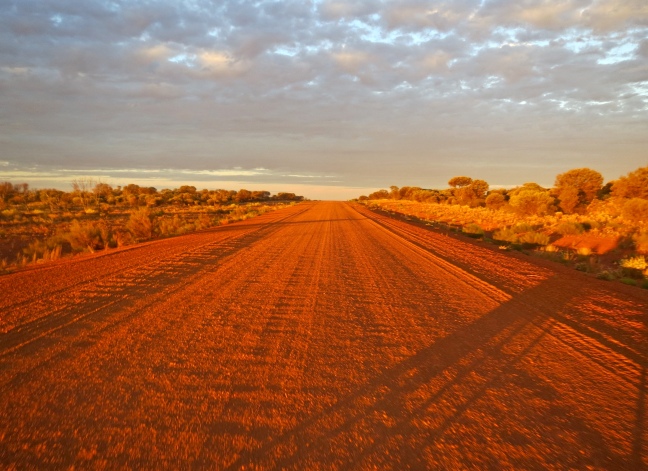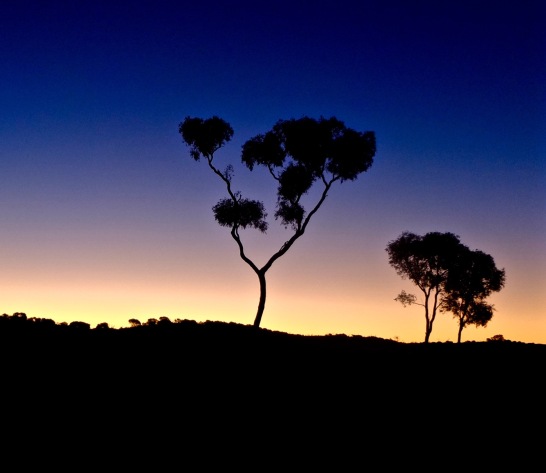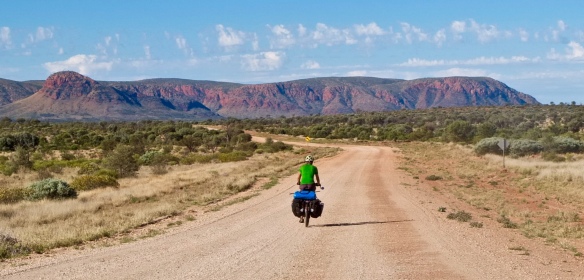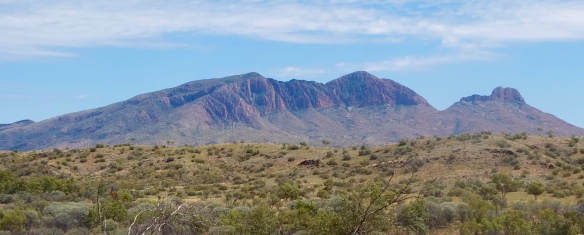
Riding into the sunset on the Great Central Road. Photo by Dan Calverley
A whole lot can come out of nothing. Well, sort of – let me explain. The tiniest variation or sudden departure from the known monotony can seem significant – and in this case, hilarious. I am riding towards a horizon lined with spinifex shrubs – sandy, flat and unchanging for hundreds of kilometres. The closest settlement is about 250km away, with no services of any kind before it. And by settlement I mean a roadhouse (gas station with takeaway food, a campground and basic groceries) and a few hundred inhabitants, followed by another 250km of the same. Then, in the nothingness, you suddenly come across something like this.

Thanks to this random joker that made my morning…
Dan was pretty disappointed that they had run out of veggie burgers…
The Great Central Road is pretty out there. Beginning in Laverton and ending at Uluru/Ayer’s Rock, it is 1100km long with about 1000km unpaved. There are several gaps as I previously explained of 200-250km with nothing. I use the term “nothing” by modern standards – no houses, no buildings, no shops and no water for about 3 days riding. So, where did we get our water from? We had to carry it – starting out with 25-30L each. This amounts to an extra 25-30kg in weight on the bikes.

24.5L of water that I carried on the bike. Dan had 33L at one point!

First roadhouse, approximately 250km from Laverton. Pronounced “joo-kay-er-la.” They had delicious burgers.
In between settlements you could make a game of counting the number of smashed up cars lining the road.


Riding the Great Central Road is a great way to really “get out there” and get in touch with nature. A strong headwind blowing sand, bone rattling washboard, thousands of flies dive bombing your face, evil thorns clinging to your tires and clothing – this is the real nature. It’s a picture f*cking postcard.

Thorns galore

Eventually the fly net becomes necessary. Photo by Dan Calverley
But, call me a masochist – I actually quite enjoyed it! Well, not so much the above mentioned features. I loved the isolation, the bush camping and the ochre coloured road in the evening light.


Great Central Road


And of course, the sunsets.





If you look closely you can see Uluru on the left and Kata Tjuta on the right. Photo by Dan Calverley

I have a bit of a thing for red dirt – not only the American musical style, but the rich hued soil that covers this continent. Seeing photos of these dirt tracks traversing a vast landscape inspired me to ride here. It held a very strong appeal that I can’t really explain.

Red Dirt Girl. Photo by Dan Calverley

Gee, really? Photo by Dan Calverley
The rough condition of the road was one of the bigger challenges that we experienced.But the dirt road misadventures didn’t begin here. Leading up to the Great Central Road we took an even rougher track.

Donkey Rocks “road” Photo by Dan Calverley
Donkey Rocks Road. The main objective here was to avoid the main highway to Leonora from Kalgoorlie. We had hoped for a fairly decent dirt road and instead got a sand pit. Some locals passed us on our way out of Kalgoorlie and we asked them about the condition of the road. “It’s quite sandy, it’s not really a road,” the friendly driver told us. Our cyclist’s ego kicked in a bit and we thought “they don’t know what’s it’s like for us on bikes, we’ll be fine.”
We should have listened. Because sandy for a 4WD vehicle equals impassable on a bicycle.

Just a tad sandy…

and as smooth as ever…

A rare (relatively) good stretch of road along Donkey Rocks
And eventually the sand became so deep that it was easier to push our bikes through the bush.

Wildlife encounters along Donkey Rocks road
On the plus side, we saw emus, kangaroos and not a single soul or vehicle for three days. Except for this one…

“That guy came out of nowhere!”
Abandoned farmsteads and random fences gave us subtle reminders that human life once existed in this remote corner.

Abandoned farmstead
Travelling in such remote areas, encounters with people are few. Along the Great Central Road each day we would only encounter a handful of locals in beater cars or caravan tourists flying over the washboard past us. Quite a few would stop to make sure that we were OK, that we had enough water or tell us that there were better, easier ways to see Australia. Over the span of a few weeks we also met a few “road angels” – those wonderful individuals looking to help out the weary traveller. Our first encounter was on a dirt road out of Kalgoorlie. Two guys coming from a funeral and on their way to a wedding at a farmstead stopped to give us ice cold beer. Were we dreaming?

“Road angels” delivering us cold beer. Yes, this actually happened.
About 40km from Tjukayirla Roadhouse on the Great Central Road, a road maintenance worker stopped to talk to us. He showed us a collection of photos on his iPad of other touring cyclists that he had met. Then, he asked if we wanted some fruit. He opened up a cooler and told us to help ourselves to oranges, apples and bananas. At the time, it was 38 degrees with screaming headwind and swarming flies. You can’t imagine how good that apple tasted.
And then there was Liesel in Warburton who went into the community shop that we couldn’t access as tourists to buy us groceries, refusing to let us pay. Also, a man surveying the condition of the North Territory section of road who chatted to us in the morning and found us later having lunch under a bush. He pulled his truck into our spot and gave us two cold cans of coke that he had bought in Docker River.
These small, simple acts of kindness went a long way, like finding oases in the harshness of the desert.
As for wildlife encounters, we didn’t have as many as we expected. A few camels, one tiny snake and this thorny little devil. Dan nearly ran the little guy over – he easily could have punctured a tire!

Thorned devil
As we progressed East, the flat mulga and spinifex country slowly started to transform into hills as we followed the 550 million-year-old Petermann Ranges. Scrub brush turned into desert oaks along the road, giving the appearance of a pleasant tree lined avenue in a city suburb. The desert oak is unique to the dry, desert regions of the Northern Territory, Western Australia and South Australia and can be found no where else in the world.

Riding along the 550 million-year-old Petermann Range



The desert oak, a truly resilient tree

Desert avenue. Photo by Dan Calverley
Now, we were edging closer to Uluru (Ayer’s Rock), one of Australia’s biggest tourist attractions – that iconic big red rock. We were perhaps more excited to be hitting tarmac after weeks of rough road that seemed to worsen the further we progressed. Before Uluru, we passed Kata Tjuta, its name meaning “many heads” in the aboriginal Pitjantjatjara language. Along with Uluru it is a sacred site.

Kata Tjuta, seen from the Great Central Road



View of Kata Tjuta from our campsite
Before seeing Uluru, I didn’t allow myself to create any expectations. I find often that these “must see” tourist sites become so overhyped that it inevitably will lead to some form of disappointment. I didn’t experience this when I set eyes on Uluru. This enormous monolith exudes a presence over the landscape that cannot be captured in a photo. Such a dramatic formation rising suddenly out of a flat, barren land. It was captivating to look at.

Riding towards Uluru

Photo by Dan Calverley

As the light changes throughout the day, so does the colour and appearance of the rock.
Instead of going for the $38/pp campground in Yulara we pulled off the main road onto a sandy track. Someone had left behind a few chairs and a mattress, so it added to our typical bush camping setup.

“Luxury” bush camp. Photo by Dan Calverley

Complimentary camp chairs
Next we turned North onto the Mereenie Loop, where we visited King’s Canyon and the West Macdonnell range. This route has been the highlight of Australia for me so far.

King’s Canyon

King’s Canyon. Photo by Dan Calverley

Into the West Macdonnell Range via the Mereenie Loop along a rough section of road




The undulating formations of the range followed us for the majority of the route. It was a great surprise to hear about the number of gorges that offered ice cold swimming holes. After a very sweaty 50km we reached Redbank Gorge for our first swim. It was a heavenly refuge from the intense heat trapped in by the towering rock faces.

Redbank Gorge
After the swim we hiked 15km roundtrip to the summit of Mount Sonder for a spectacular sunset view of the West Macdonnell Range. The majority of the descent we traversed in the dark and didn’t end up returning to our bikes until about 8:30pm. We had underestimated the amount of water we would need for the trek and returned very tired and dehydrated. It was a fairly intense day of activity, but definitely worth it.

The West Macdonnell Range from the summit of Mount Sonder. Photo by Dan Calverley

Photo by Dan Calverley

The return hike from Mount Sonder summit

Sunset over Mount Sonder


The West Macdonnell Range
Our next stop was Ellery Creek Big Hole, another excellent spot for swimming. I can’t think of many swims in my life that have been quite like this. It was a unique way to view the world – floating in between a dramatic enclosure of red cliffs towering above.



Dan and I have now reached Alice Springs and are about halfway to Sydney. We are taking some much needed rest with our great Warm Showers hosts Andrea and Laurie. The sandy, rough roads are now behind us (but unfortunately not the flies) and we are heading south to Adelaide, where I will reunite with Callan, a very close friend of mine from my hometown, Toronto. Travelling through the Australian outback the slow way has given me a sense of the enormity of the landscape. It is a vast, vast wilderness. The ability to experience this is a feature of Canada that I have come to miss on my travels – that wild presence that is created by endless, uninhabited space. The Australian outback is a harsh, unforgiving place, even for those just passing through. The conditions often made for a challenging bike ride, but I really enjoyed it (most of the time). On a journey like this, the tiniest occurrences like being given a cold drink, bizarre wildlife sightings or a joke McDonald’s drive thru sign can offer the biggest (and unexpected) rewards. The land isn’t really empty – it is full of resilient life struggling to survive the rigours of the desert. From a whole lot of nothing, a great something emerges.





Absolutely fantastic. I have visited Oz, but not the Red Centre. Your report is lovely to look at, but from your writing, was more than a little tough. Aussies are great friendly folk, may you meet many more ” road angels”. By the by, is there an Australia Part 1. The best of luck on the next part. Pat
Sent from my iPad
>
LikeLike
Thanks Pat 🙂 Yes, here is part 1 – https://followmargopolo.com/2016/09/29/australia-part-i-love-down-under/
LikeLike
Loving every second of it T.
You guys enjoy yourselves.
Much love BBo
LikeLike
Wonderfully told Tara!
LikeLike
An excellent read Tara. The photos remind me of our holiday with our kids back in 2000 when we visited all the same places but by car! We’re much more into long distance cycling now but not on your scale. Which reminds me – I’m writing this on 17 January, 2 years to the day in which I, my good friend Mark and several others set off with Dan from the Co-op in Glossop on the start of this very adventure! Hope you both a had a good celebration!
LikeLike
Thanks Tara for the pictures and stories..
LikeLike
Pingback: My Top 10 Places in the World to Ride a Bike (so far) | Margo Polo